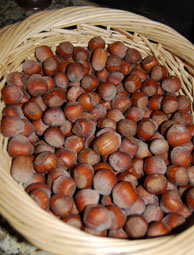It’s said that you don’t plant nut trees for yourself; you plant them for generations to come. But you may not have to wait long to enjoy your crop—some grafted trees start bearing fruit within one year of planting. Once nut trees are established, their generally low maintenance makes them an attractive addition to any hobby farm.
Success with nut trees depends on factors that include topography and climate; the type, pH and fertility of your soil; the availability of moisture; and the prevalence of pests and diseases in your region—even the whims of local squirrels, chipmunks and jays, who can decimate your orchard but leave your neighbor’s untouched.
Before purchasing and planting nut trees, ask yourself these questions:
- How much space do you have?
- How impatient are you to taste your first crop?
- How quickly can you harvest more than a handful of nuts?
- How much work are you prepared to do throughout the year to keep your trees healthy and pests at bay, and how much work at harvest time?
- What’s your favorite nut?
In addition to answering these questions, Sandra Anagnostakis, PhD, a chestnut scientist at the Connecticut Agricultural Experiment Station, suggests, “Find out what kinds of trees will grow in your climate and in your soil. Look around to see what grows well in your area.”
A local soil-testing lab can test your soil’s pH (your county extension agency might be able to, too), and employees at state departments of agriculture and agricultural colleges might be able to offer advice and share their enthusiasm for their favorite trees.
Nut-tree breeders shipping across the U.S., as well as your local nursery, should know what nut-tree varieties perform well in your region. Nonprofit organizations, such as the Arbor Day Foundation and the Northern Nut Growers Association, provide news about the latest cultivars (plant varieties that have been deliberately selected for specific desirable characteristics) and information on the best techniques for planting and successful cultivation.
Preventing Pests in Nut Trees
“If you’re only growing 1/2 to 5 acres of trees close to a woodlot, squirrels will be your biggest nightmare,” says Molnar, and other growers agree.
Nut kernels go from liquid to jelly to a dough-like stage when they’re still green—mid-July for walnuts and mid-August for pecans. That’s when squirrels start cutting them down from the trees.
“But if you have one or two dogs that run free,” says Molnar, “that’ll do the trick.” Cats can also help with a squirrel problem.
Playing recorded bird distress calls or predator cries in your orchard will help scare away blue jays, which also love nuts.
Harvesting Nuts
Once nut trees are established, the biggest input of time and effort is at harvest—gathering, preparing and preserving the nuts. Even if you’re using a machine to shake the tree, “rubber fingers” to pick the nuts off the ground and a mechanized cleaner to remove debris, you’ll still need to inspect the hulled nuts. If you put them in water, damaged, diseased or old nuts will usually float to the top.
The nuts should be dried in their shells to reduce moisture content to less than 10 percent, which discourages potentially dangerous molds and improves flavor and texture. Lay the nuts in a single layer in a cool, dry, well-ventilated place or on a screen so air circulates around them, says Reid. It may take a week to three weeks until the kernels rattle in their shells, lose their rubberiness and snap when bent. To speed the process, use blowers or dryers. Once they’re dry, store in-shell nuts in a cool place.
To extract the kernels, commercially available specialty nut crackers may be worth the investment for speed and control, but even a common bench vise will crack the hardest shells. Most nuts are very high in protein and in heart-healthy oils—pecans and hazelnuts can be almost 75 percent oil. Freezing shelled nuts will stop their oils from oxidating, which is what causes rancidity. They keep well for years if frozen in airtight glass or hard-plastic containers, preventing the nuts from absorbing off flavors from their surroundings.
Chestnuts are the exception. The nuts are almost entirely carbohydrate, and unlike other nuts, dried chestnuts are “rock-hard and useless,” says Anagnostakis. At harvest, Anagnostakis recommends dipping the nuts in hot water to control a weevil that lays its eggs in the nuts as they ripen or as the burrs open. She says weevil control is not difficult: Soak the nuts at 122 degrees F for 30 minutes, then immediately cool to 32 to 34 degrees F to kill weevil eggs before they hatch. Because of their high moisture content—about 25 percent—fresh chestnuts must be kept cold after harvesting to prevent mold and, like other fresh produce, should only be sold from a refrigerated case.
Whatever nut trees you’re most fond of, the most important thing is to “Grow what your land is really suited for, and grow what grows well,” says Reid.














